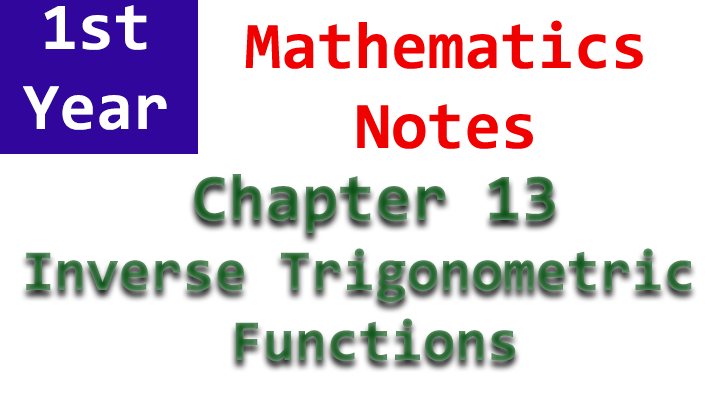In the mathematics, few topics hold as much intrigue and practical significance as the study of Inverse Trigonometric Functions. Chapter 13 of the first-year mathematics curriculum for F.Sc (Intermediate) students delves into this fascinating branch of mathematics. In this chapter, students will embark on a journey that unravels the mysteries of inverse trigonometric functions, exploring their properties, applications, and the profound role they play in solving complex mathematical problems. As we embark on this educational voyage, we will unlock the power of inverse trigonometric functions, enabling us to delve deeper into the intricate world of mathematics and its numerous real-world applications.
We have been accustomed to finding the values of trigonometric functions given specific angles, but in the realm of trigonometry applications, the problem is often reversed. We are frequently tasked with determining the measure of an angle when provided with the value of its trigonometric function. To tackle this, we require an understanding of inverse trigonometric functions.
In a previous chapter, we delved into the concept of inverse functions and learned that only one-to-one functions possess an inverse. If a function is not one-to-one, we can often restrict its domain to make it one-to-one and, consequently, derive its inverse.
In the subsequent sections, we will define these inverse trigonometric functions:
13.2 The Inverse Sine Function: The sine function, represented by y = sin(x) for -π < x < π, is shown in Figure 1. It becomes apparent that every horizontal line between y = 1 and y = -1 intersects the graph an infinite number of times, indicating that the sine function is not one-to-one. However, by confining the domain to [-π/2, π/2], we obtain the principal sine function, which is one-to-one and thereby has an inverse, known as the inverse sine function or sin⁻¹(x).
The Inverse Sine Function is defined as: y = sin⁻¹(x) if and only if x = sin(y), where -1 ≤ x ≤ 1. The domain of sin⁻¹(x) is -1 ≤ x ≤ 1, and its range is -π/2 ≤ y ≤ π/2. The graph of y = sin⁻¹(x) is obtained by reflecting the restricted section of y = sin(x) about the line y = x.
Note: It is crucial to remember that sin⁻¹(x) is not the same as (sin(x))⁻¹.
Example 1: We illustrate how to find the values of sin⁻¹(x) for specific x values.
13.3 The Inverse Cosine Function: The cosine function, y = cos(x) for -π < x < π, is depicted in Figure 4. Similar to sine, the cosine function intersects every horizontal line between y = 1 and y = -1 infinitely, indicating it is not one-to-one. Nevertheless, by restricting the domain to [0, π], we establish the principal cosine function, which is one-to-one and possesses an inverse known as the inverse cosine function or cos⁻¹(x).
The Inverse Cosine Function is defined as: y = cos⁻¹(x) if and only if x = cos(y), where 0 ≤ y ≤ π and -1 ≤ x ≤ 1. The domain of cos⁻¹(x) is -1 ≤ x ≤ 1, and its range is 0 ≤ y ≤ π. The graph of y = cos⁻¹(x) is created by reflecting the limited portion of y = cos(x) about the line y = x.
Note: It is essential to remember that cos⁻¹(x) is not equivalent to (cos(x))⁻¹.

